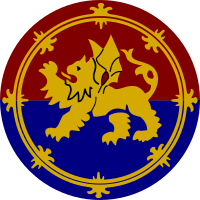Commander-in-Chief, Home Forces

Commander-in-Chief, Home Forces was a senior officer in the
equipment of formations in preparation for their deployment overseas, and secondly, to command the forces required to defend the United Kingdom
against an enemy incursion or invasion.
The First World War

The post was created for
anti-aircraft artillery.[1]
Commanders-in-Chief, Home Forces, 1915 to 1921
- Field Marshal Sir John French – December 1915 to May 1918
- Field Marshal Sir William Robertson – 1918 to 1919 [2]
- Field Marshal Lord Haig – 1919 to 1921 [3]
The Second World War

The post of Commander-in-Chief, Home Forces was resurrected for Sir Walter Kirke on 3 September 1939.[4] He devised the first anti-invasion plan of the war in October, known as Operation Julius Caesar.[5] His successor, Sir Edmund Ironside was replaced by Sir Alan Brooke in July 1940. The headquarters was established at Kneller Hall in late 1939 but moved out to St Paul's School in July 1940.[6]
Commanders-in-Chief, Home Forces, 1939 to 1945
- General Sir Walter Kirke – September 1939 to May 1940
- General Sir Edmund Ironside – May to July 1940
- General Sir Alan Brooke– July 1940 to December 1941
- General Sir Bernard Paget – December 1941 to January 1944
- General Sir Harold Franklyn – January 1944 to 1945[7]
References
Sources
- Cassar, George H. (1985). The Tragedy of Sir John French. University of Delaware. ISBN 978-0-87413-241-0.
- Grossman, Mark (2006). World Military Leaders: A Biographical Dictionary. Facts on File. ISBN 978-0-8160-4732-1.
- Newbold, David John (1988). British Planning and Preparations to Resist Invasion on Land, September 1939 – September 1940 (pdf). kclpure.kcl.ac.uk (PhD). King's College, University of London. OCLC 940319374. Retrieved 1 August 2015.
- Place, Timothy Harrison (2000). Military Training in the British Army, 1940–1944: From Dunkirk to D-Day. London: Routledge. ISBN 978-0-7146-8091-0.
- Taylor, A. J. P. (1965). English History 1914–1945. Oxford University Press. p. 47. ISBN 978-0-19-821715-2.
Further reading
- Collier (1956), Defence of the United Kingdom. Dispositions of Home Forces 1 May 1940, accessed November 2011.
